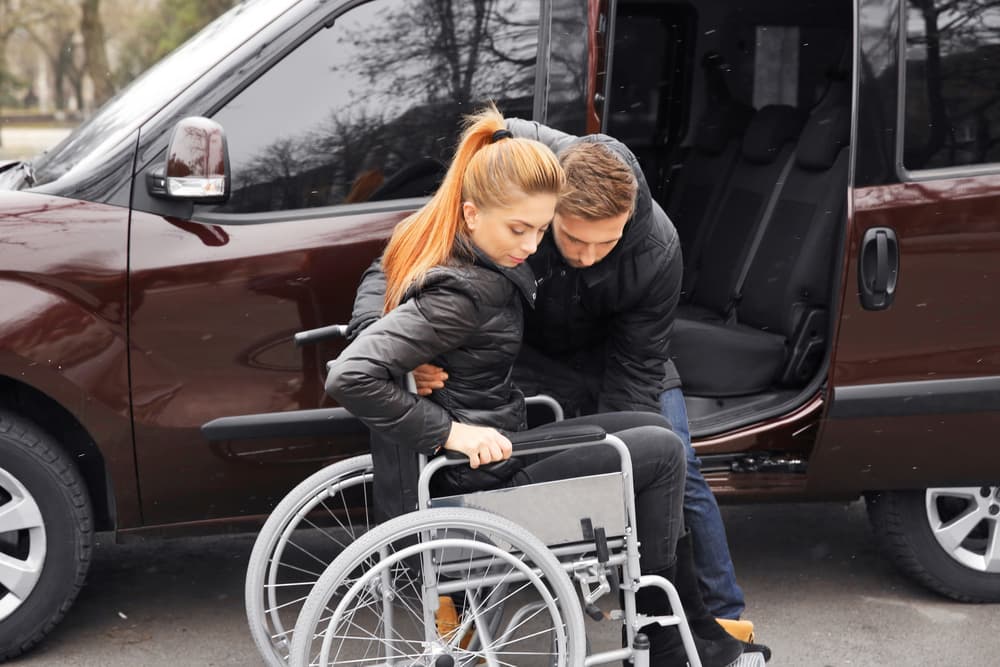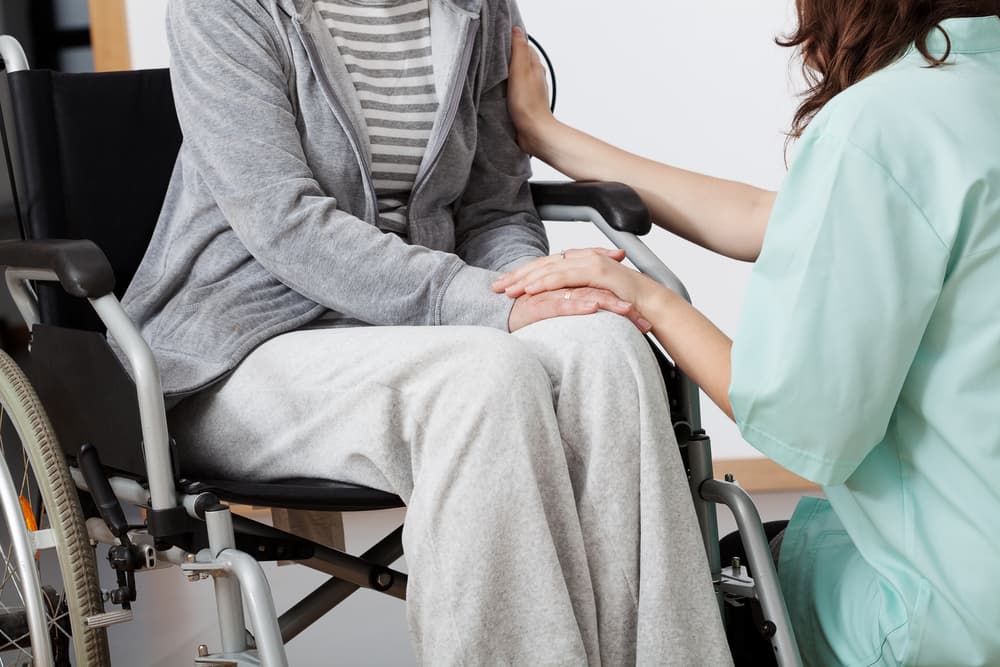Paralysis due to a spinal cord injury may be a challenging and demanding experience for anyone, as it limits physical movement and has far-reaching effects.
There are also psychological and emotional effects of paralysis due to spinal cord injuries (SCIs), such as post-traumatic stress disorder (PTSD), sadness, stress, and anxiety. This is why helping a newly paralyzed person is so important.

Dealing with the News
When first told they have paralysis, most people experience shock and disbelief and may feel hopeless. The first step in providing appropriate care for a paralyzed loved one is to understand paralysis fully and its effects on your loved one, what emergencies can occur, and the treatments and care your family member will need.
Caregivers should expect their loved ones to go through a sequence of events as they adjust to their new reality, including grieving, recovering mobility, communicating the disability, and planning for the future.
However, this does not imply that you let these emotions impact your role as a family caregiver. You should maintain calmness, comfort, and compassion toward them.
Nevertheless, some tips to remember below will help you give them hospital-quality treatment at home and move forward.
How to Care for a Paralyzed Person at Home

Over half of the more than 90 million people in the United States who provide care or assistance for a family member or a friend with spinal cord injuries do it at home. Even people with disabilities who live in nursing homes prefer home care.
When a person chooses to stay at home, they often make few changes to their usual routine and regular schedule.
Caregiver responsibilities include ensuring the injured individual with spinal cord injury receives all appropriate home care and lives at ease.
Emotional care for spinal cord-injured patients.
One of the most important things caregivers can do for their loved ones is to ensure they stay connected, involved, and productive. Their mental health is just as important as their physical disability. Paralyzed individuals often suffer from mood swings, anxiety, and sadness.
As the main person taking care of your loved one, there are things you can do to ease the mental stress caused by paralysis. Support and encourage them to maintain relationships with friends and family. You can talk to them to express their feelings and help them reduce their negative thoughts about their condition.
Paralysis also increases the risk of depression, especially in the weeks and months immediately following injury, and is found to affect 1 out of 5 spinal cord-injured people. It is essential to recognize the symptoms of depression and get treatment from a medical expert. Some signs are oversleeping, changing weight, a lack of interest or pleasure, and negative thinking.
You may count on the support of your friends and family, but they can’t replace the expertise of a licensed mental health professional.
Always be there to talk or listen to what they want to say, as people who have suffered a spinal cord injury need reassurance that they are still loved and cared for and, most of all, that they are not alone in their challenge.
Body care for spinal cord injury patients
Depending on the site of paralysis and its severity, paralyzed people may also be at greater risk of a wide range of secondary conditions, like pressure injuries or sores, blood pressure variations, spastic body syndrome, muscle pains, loss of sexual function, bowel or bladder issues, and autonomic dysreflexia.
These things can be avoided as:
- Pressure sores can be avoided by assisting your loved one with exercises and position changes many times a day and by keeping their skin dry and clean.
- Bathing or towel sponging can be done for better hygiene.
- Circulatory disorders like blood clots can be avoided with a routine of occupational therapy.
- For bladder and bowel management, caregivers may help by hydrating, keeping a bowel diary, eating a nutritious, fiber-rich diet, using laxatives per doctor’s prescription, and keeping up good physical activity.
Transfers and Positioning
Understanding how to position your loved ones for increased comfort is essential.
Depending on the patient’s general state and health, several mobility aids can help your loved one get around. Whether a manual or electric wheelchair or orthoses, devices linked to the legs to aid movement can help your loved one get around easily.
Consider body transfers by ensuring sufficient space to go from a wheelchair to furniture or the toilet comfortably.
In this video, the physical therapist Dr. John teaches how to transfer a paralyzed person from a wheelchair to a bed with the help of a board.
This video demonstrates how to safely move a paralyzed person from their bed to the toilet and from their chair to their bed to prevent injury to the patient and his or her family.
Home adjustments for people with spinal cord injuries
Special precautions must be taken to prevent falls and accidents, as they can occur easily and impede rehab and recovery.
As a measure, you should make your house accessible for your loved one with limited mobility by adding ramps in the restroom, along stairs, and in the patient’s bedroom, wheelchair lifts, expanding doorways, etc.
Place commonly used things within easy reach in the kitchen and living area, such as on the lowest shelf or in the center of a countertop.
Rearranging your power outlets, light switches, and thermostat may be convenient. They should be 30–48 inches above the ground.
This home care for a paralyzed loved one can result in improved health and complete independence. It can also help make a paralyzed person feel more included and valued.
Exercise is Essential.
Among the numerous difficulties people face after an injury is a lack of physical activity. Not being able to move around as easily as before is no excuse for ignoring the need to maintain a regular workout routine. It also plays a massive role in their mental wellness and the reduction of muscular pain.
Physical therapy, range-of-motion exercises, and stretching exercises for the whole body or legs are essential.
The physical and occupational therapists can help you with any questions or concerns, so don’t be afraid to ask them anything.
Set different goals
People living with paralysis may feel useless in their existence. That is why, as a caregiver, one must help them set different daily or weekly goals to feel important. Such as some smaller ones like wearing a sock on their own or performing exercises without help.
Aiming for such wholesome and doable goals has become something of a pastime.
Find useful activities

While paralysis from a spinal cord injury might make movement difficult or cause job loss, many enjoyable activities are still open to people in wheelchairs.
Think about what the person liked to do for fun before the injury. Other things that can be tried are gardening, pottery, painting, photography, or doing crosswords or board games. Or you can plan a movie together or a visit to the park.
Most things can be adapted so that your loved one may take part.
Joining a support group
Isolation is a serious issue in the paralysis community. So encourage loved ones to join spinal cord injury support groups and assist them in obtaining professional mental health care. Speaking with other spinal cord injury patients can help them adapt to their condition and give them hope for a better life.
Pre-plan the outing
If you are taking a loved one out for a walk or movie, carry a small bag or backpack with all the essential stuff, like trash bags. Locate nearby restrooms in case you find yourself in need of an unexpected pit stop.
Don’t let them lose hope
Finally, one of the most successful methods is to rediscover the things and activities a person living with a spinal cord injury once loved. You can help them try or develop new hobbies; for example, if they were physically active before, they can still enjoy adaptive sports like wheelchair basketball.
If not, engage in healthy habits like volunteering at local organizations. This aims to motivate them and keep them going.
By following these tips, you can make a difference in the life of someone who has recently experienced this problematic situation and helps them in their spinal cord injury recovery.
Tip for Caregivers
It may be emotionally and physically taxing to care for a paralyzed loved one. To avoid caregiver burnout, medical professionals recommend that family members take breaks and engage in relaxing activities such as chores, socializing, and maintaining a life outside of work regularly.
They also suggest caregivers join support groups, as without proper support, caregivers are at increased risk for mental health issues, including depression and anxiety.
Mason Ellis, a YouTuber, and quadriplegic himself shares his tips for caregivers to help loved ones with spinal cord injuries. He shares that it’s beneficial to understand injury and its certainties and uncertainties, which is a great place to start. He further suggests helping them set and achieve goals, feel important, and have hobbies.
Real-life examples of family members as caregivers
Dana Reeve understood the significant change that followed a spouse’s paralysis. Dana became her husband’s primary caregiver when actor Christopher Reeve suffered a spinal cord injury while horseback riding. Dana Reeve understood the major change that followed a spouse’s paralysis. She endured the difficult process of learning to care for a paraplegic through the stages of grief and came to terms with the difficulties and constraints of her new life as a caregiver.
In her memoir, Some Things Are Unbreakable, author and public speaker Kate Willette discusses the impact of her husband’s spinal cord damage on their lives and shares her tips and experiences.
Before You Go
Research suggests that neurological damage significantly affects spinal cord injury survival and life expectancy. But with the advancement in science, it improved considerably over the previous few decades, becoming comparable to that of the general population with no physical impairments. Read my article on the life expectancy of someone in a wheelchair to find out the details.

